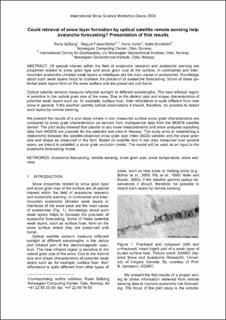| dc.contributor.author | Solberg, Rune | |
| dc.contributor.author | Frauenfelder, Regula | |
| dc.contributor.author | Koren, Hans | |
| dc.contributor.author | Kronholm, Kalle | |
| dc.date.accessioned | 2023-10-25T18:43:20Z | |
| dc.date.available | 2023-10-25T18:43:20Z | |
| dc.date.issued | 2009 | |
| dc.identifier.uri | https://hdl.handle.net/11250/3098811 | |
| dc.description.abstract | Of special interest within the field of avalanche research and avalanche warning are properties related to snow grain type and snow grain size at the surface. In continental and intermountain avalanche climates weak layers or interfaces are the main cause of avalanches. Knowledge about such weak layers helps to increase the precision of avalanche forecasting. Some of these potential weak layers form on the snow surface and are preserved until burial. Optical satellite sensors measure reflected sunlight at different wavelengths. The near-infrared region is sensitive to the optical grain size of the snow. Due to the distinct size and shape characteristics of potential weak layers such as, for example, surface hoar, their reflectance is quite different from new snow in general. If the weather permits optical observations it should, therefore, be possible to detect such layers by remote sensing. We present the results of a pilot study where in situ measured surface snow grain characteristics are compared to snow grain characteristics as derived from multispectral data from the MODIS satellite sensor. The pilot study showed that parallel in situ snow measurements and snow analyses exploiting data from MODIS are possible for the selected test sites in Norway. The study aims at establishing a relationship between the satellite observed snow grain size index (SGS) variable and the snow grain size and shape as measured in the field. Based on satellite and in situ data measured over several years, we intend to establish a snow grain evolution model. The model will be used as an input to the avalanche forecasting model. | en_US |
| dc.language.iso | eng | en_US |
| dc.publisher | Montana State University Library | en_US |
| dc.relation.ispartofseries | The International Snow Science Workshop (ISSW) Proceedings; | |
| dc.subject | Avalanche-RnD | en_US |
| dc.subject | Snøskred-FoU | en_US |
| dc.title | Could retrieval of snow layer formation by optical satellite remote sensing help avalanche forecasting? Presentation of first results. | en_US |
| dc.type | Chapter | en_US |
| dc.source.pagenumber | 4 | en_US |
